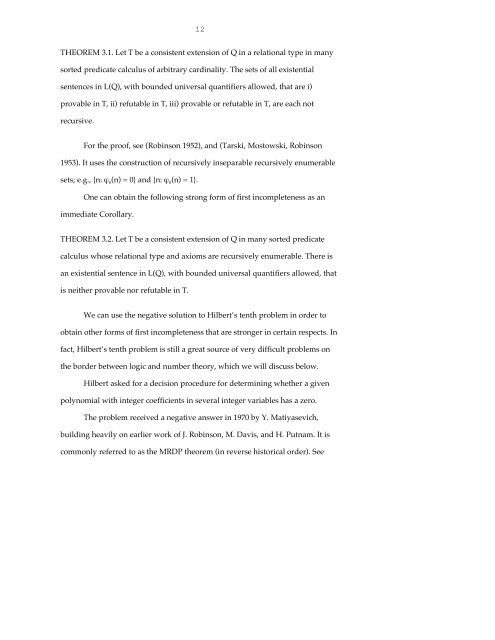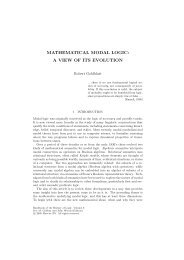my forty years on his shoulders - Department of Mathematics
my forty years on his shoulders - Department of Mathematics
my forty years on his shoulders - Department of Mathematics
- No tags were found...
Create successful ePaper yourself
Turn your PDF publications into a flip-book with our unique Google optimized e-Paper software.
12THEOREM 3.1. Let T be a c<strong>on</strong>sistent extensi<strong>on</strong> <strong>of</strong> Q in a relati<strong>on</strong>al type in manysorted predicate calculus <strong>of</strong> arbitrary cardinality. The sets <strong>of</strong> all existentialsentences in L(Q), with bounded universal quantifiers allowed, that are i)provable in T, ii) refutable in T, iii) provable or refutable in T, are each notrecursive.For the pro<strong>of</strong>, see (Robins<strong>on</strong> 1952), and (Tarski, Mostowski, Robins<strong>on</strong>1953). It uses the c<strong>on</strong>structi<strong>on</strong> <strong>of</strong> recursively inseparable recursively enumerablesets; e.g., {n: ϕ n (n) = 0} and {n: ϕ n (n) = 1}.One can obtain the following str<strong>on</strong>g form <strong>of</strong> first incompleteness as animmediate Corollary.THEOREM 3.2. Let T be a c<strong>on</strong>sistent extensi<strong>on</strong> <strong>of</strong> Q in many sorted predicatecalculus whose relati<strong>on</strong>al type and axioms are recursively enumerable. There isan existential sentence in L(Q), with bounded universal quantifiers allowed, thatis neither provable nor refutable in T.We can use the negative soluti<strong>on</strong> to Hilbert’s tenth problem in order toobtain other forms <strong>of</strong> first incompleteness that are str<strong>on</strong>ger in certain respects. Infact, Hilbert’s tenth problem is still a great source <strong>of</strong> very difficult problems <strong>on</strong>the border between logic and number theory, which we will discuss below.Hilbert asked for a decisi<strong>on</strong> procedure for determining whether a givenpolynomial with integer coefficients in several integer variables has a zero.The problem received a negative answer in 1970 by Y. Matiyasevich,building heavily <strong>on</strong> earlier work <strong>of</strong> J. Robins<strong>on</strong>, M. Davis, and H. Putnam. It iscomm<strong>on</strong>ly referred to as the MRDP theorem (in reverse <strong>his</strong>torical order). See
















